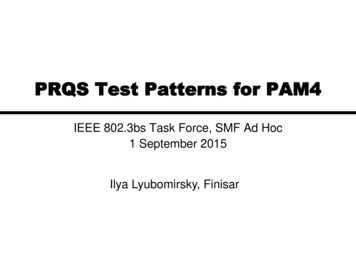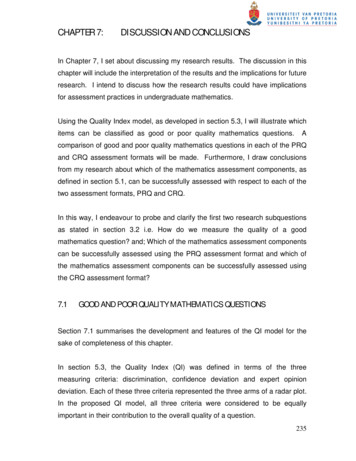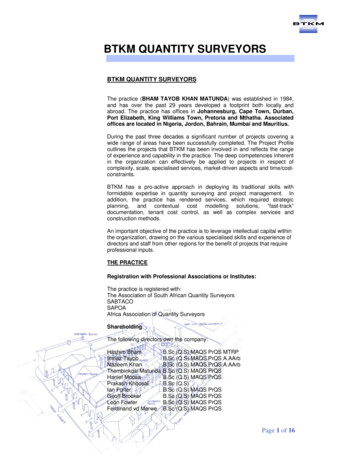
Transcription
PRQS Test Patterns for PAM4IEEE 802.3bs Task Force, SMF Ad Hoc1 September 2015Ilya Lyubomirsky, Finisar
Outline ObjectivesPRQS Generation TechniquesAnalysis and Discussion1 September 20152IEEE 802.3bs SMF Ad Hoc
Objectives Propose the pseudo random quaternary sequence(PRQS) as a test pattern for PAM4 Describe efficient methods for generating PRQS1 September 20153IEEE 802.3bs SMF Ad Hoc
Why PRQS for PAM4? PRQS patterns provide many of the same advantages forPAM4 systems as PRBS patterns for NRZ systems PRQS patterns closely match the properties of randomPAM4 data PRQS patterns are generated algorithmically using linearfeedback shift registers1 September 20154IEEE 802.3bs SMF Ad Hoc
The Algebra of PRBS GenerationStates cycle throughall nonzero elements ofGF(23) constructedfrom binary primitivepolynomial P(x) x3 x 1PRBS generator is based on a primitive polynomial with coefficients in GF(2) Similarly PRQS requires a primitive polynomial but with coefficients in GF(4)1 September 20155IEEE 802.3bs SMF Ad Hoc
GF(4) Arithmetic1 September 20156IEEE 802.3bs SMF Ad Hoc
Primitive Polynomials over GF(4)X2 X 2X7 X2 2X 3X10 X3 2X2 2X 2Note in the notation above GF(4) {0, 1, A, B}Source: D. H. Green, et. al. “Irreducible Polynomials over Composite Galois Fields andtheir Applications in Coding Techniques,” Proc. IEE, vol. 121, no. 9, pp. 1935-1939,19741 September 20157IEEE 802.3bs SMF Ad Hoc
Example: PRQS2 Generator (length 42-1)OutputS2S112P(x) x2 x 2GF(4)1 September 20158S1 S21 00 12 12 31 12 00 23 23 12 23 00 31 31 23 31 0Output011310221203323IEEE 802.3bs SMF Ad Hoc
PRQS Generator by PRBS MultiplexingPRBS4LSBPRBSnPRBSnShiftm n/2 bitsMSBDibit-tosymbolmapperPRQSmPRQS23 1 3 3 2 2 0 1 0 2 1 1 2 3 0PRBS4 shifted by 2 bitsSource: D. van den Borne, et. al., “Pseudo Random Sequences for Modeling of QuaternaryModulation Formats,” proceedings OECC/IOOC, Pacifico Yokohama, July, 20071 September 2015IEEE 802.3bs SMF Ad Hoc
Proposed PAM4 Test Pattern: PRQS10LSBPRBS20PRBS20Delaym 10 bitsMSBDibit-tosymbolmapperPRQS10 Algorithmically generated based on multiplexing two PRBS20 patterns True PRQS10 pattern, i.e. contains all 10 length symbol patterns with equalprobability (except for all 10 zeros) Pattern length 410-1 1,048,575 1 M (short enough for DCAs to support) Better “random” statistical properties compared with PAM4 from 250.75SSPR0.25730.22790.25750.25730.711 September 201510IEEE 802.3bs SMF Ad Hoc
Simulated Autocorrelation1.21.2PAM4 from PRQS100.80.60.40.20.80.60.40.200-0.20PAM4 from 000Time Lag (symbols)Time Lag (symbols)1.2NRZ from 005006007008009001000Time Lag (symbols)1 September 201511IEEE 802.3bs SMF Ad Hoc
Potential PRQS Test Patterns for PAM4PRQS-m PatternLength (4m-1)Required PRBS-2mGeneratorsApplicationPRQS716,383PRBS14Embed in PAM4chips/modulesPRQS101,048,575PRBS20R&D to support DCAsand real-time scopesPRQS14268,435,455PRBS28Longer pattern forproduction testing1 September 201512IEEE 802.3bs SMF Ad Hoc
PRQS Test Patterns for PAM4Thank you1 September 201513IEEE 802.3bs SMF Ad Hoc
Potential PRQS Test Patterns for PAM4 PRQS-m Pattern Length (4m-1) Required PRBS-2m Generators Application PRQS7 16,383 PRBS14 Embed in PAM4 chips/modules PRQS10 1,048,575 PRBS20 R&D to support DCAs and real-time scopes PRQS14 268,435,455 PRBS28 Longer pattern for production testing










